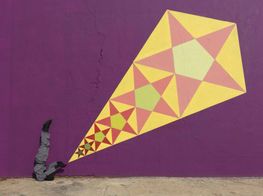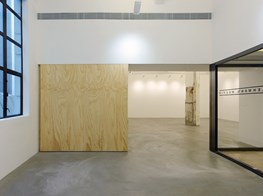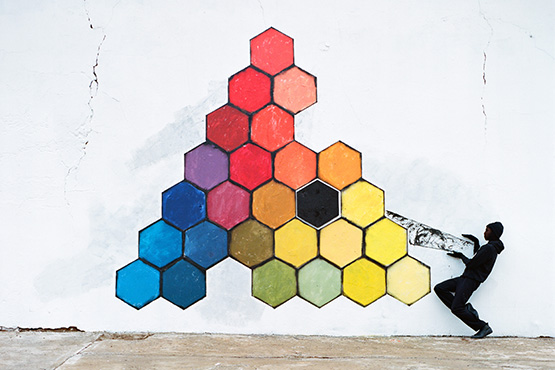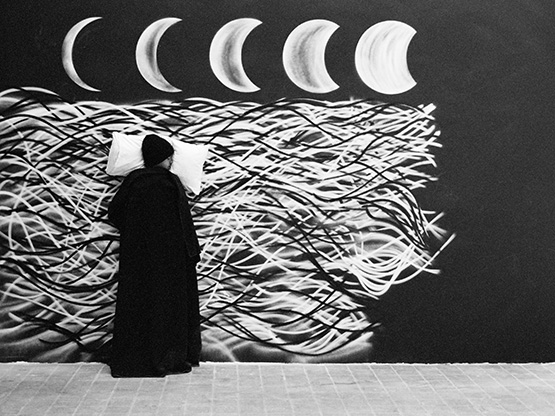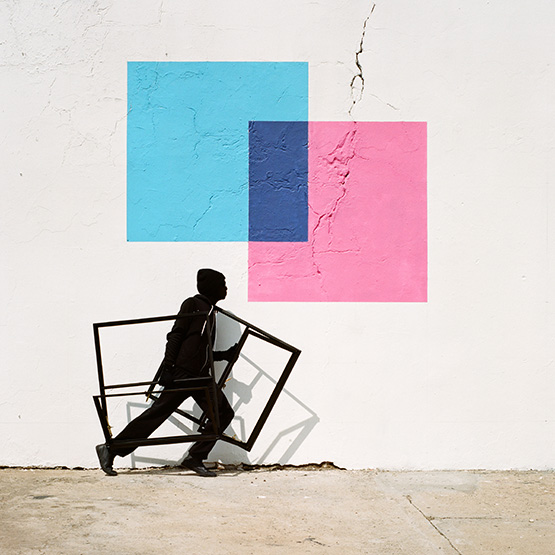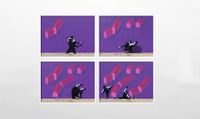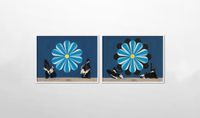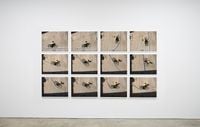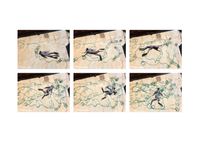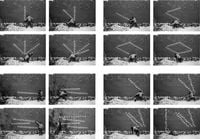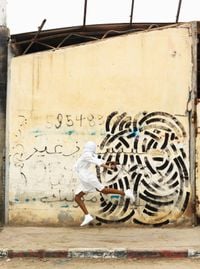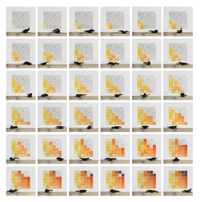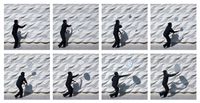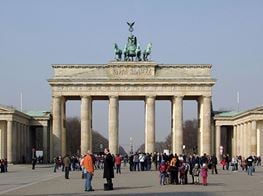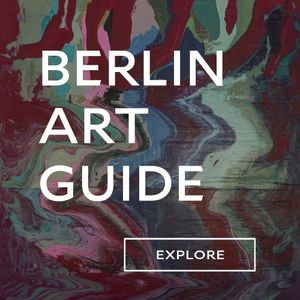Robin Rhode
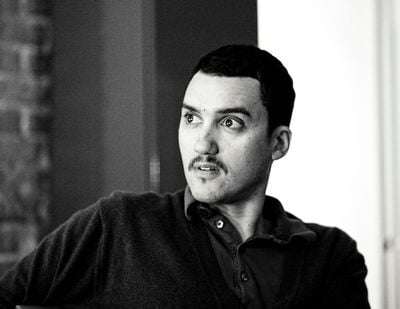
For the past couple of decades Berlin has become an international art world Mecca attracting more than 20,000 artists from around the world, including some of the biggest names in contemporary art: Tacita Dean, French artist Bernard Frize, Danish-Icelandic artist Olafur Eliasson, and American artist Julie Mehretu have come to call Berlin an adopted home, and most recently Chinese political activist and sometime artist, Ai Weiwei spent time there too. The city is more of an art culture, than an art market, and is defined more by its creatives than auction houses or mega-gallerists. Berlin is to the visual arts world what Los Angeles is to the entertainment industry, and what finance and shopping is to Hong Kong. There isn’t a latte worth its organic almond milk that hasn’t been made by an aspiring artist. There isn’t a party conversation to be had that doesn’t involve the latest exhibition and art world gossip.
Cape Town-born Robin Rhode is another Berlin creative transplant. Part of the first post-apartheid generation of South African artists, Rhode was 18 when the country experienced its first multi-racial election, won by the African National Congress under Nelson Mandela. But he was old enough that the trauma of apartheid had already settled into his bones, and the scars would be deep enough to become a permanent part of his identity. One can argue that the genesis of his artistic practice can be found in a personal experience borne out of the politics and history of this marginalisation. There was no art education in his high-school, and little in the way of instructional creative expression for students. Instead students created their own visual language. As part of an initiation ritual into high-school subculture, new students were made to draw an object, like a bike, on the toilet wall with a piece of chalk and interact with their drawings in front of the older students. While the act was aimed at ridiculing the younger student, it was a humorous way of establishing hierarchy and power. Years later, the bike became the starting point of Rhode’s practice, with Classic Bike (1998), which saw the artist attempting to mount, push and steal the chalked bike. His artistic language was formed on the streets, drawing from the urban landscape, and from the politics and history of Johannesburg where he grew up. Tapping into the traditions of street art, and the ideals of Dada and Bauhaus, Rhode uses walls as his canvas, transforming and activating the shapes and images he draws on them through physical interaction and narrative. The works are often critical of South Africa’s colonial and apartheid past and speak of marginality, but they are also playful, engaging, and witty. It is this humorous yet intelligent approach that has seen Rhode rise to international success.
Robin Rhode, RGBG, 2015. C – print, 16 parts, each: 16.65 x 24.53 inches / 42.3 x 62.3 cm; 72.52 x 104.02 inches / 184.2 x 264.2 cm (overall installation 1); 35..28 x 210 inches / 89.6 x 533.4 cm (overall installation 2).
Fourteen years ago Rhode moved to Berlin for a residency during which he fell in love with a fellow artist and writer, and decided to stay. But the city also offered him opportunity and room for experimentation. Studio spaces are abundant, living costs are reasonable, production is efficient, and culture is easily accessible. “You can walk into Gropius-Bau and see all these great shows! How amazing that you can just go and see that and have a Currywurst afterwards? It’s a luxury to be able to access levels of culture like this,” Rhode explains effusively over a cup of tea in his studio kitchen. “It is a city where you can still be avant-garde.” Once divided by a wall, today Berlin thrives under an atmosphere of freedom and creative possibility. You get the sense that as an artist, once again, like in the artistic boom of the 20s, anything is possible here. Twenty-five years after unification the city is still rebuilding and healing, still coming to terms with its complex and layered political history and trauma. But it is a city that encourages a dialogue with the past, both personal and historic. It’s unavoidable as the reminders are all there in the memorials, pockmarked buildings, museums and that long scar running through the city where once stood a wall. It seems apt that Rhode would find a place here to do the same.
After renting public walls (ironic in a city defined by a wall) onto which to execute his work, and moving from studio to studio, Rhode has recently settled into a new 600 square-foot space in the outer Berlin suburb of Reinickendorf. The studio building itself is part of a sprawling distillery complex from the 1800s. Several other buildings house an assortment of artists and collectives who were buzzing around the compound—I saw one artist being whizzed past in a wheelbarrow while another circled around him on a bicycle on the sunny Friday that I visited. Golden oldie music floated out of their studio where a small group of students were busy at work on various projects. It felt like a scene from a Dickensian madhouse. Inside a long stretch of a building lining one side of the compound, I was greeted by Rhode’s team of assistants. Inside the studio white shelves line the wall, neatly and fastidiously stacked with folders archiving all of Rhode’s work. Boxes are piled atop one another, unopened, while one of Rhode’s painted wall pieces stands boldly in its nascent stages in the centre of the room. Rhode has only recently moved in, but it is one of the neatest and most ordered moving-in scenes I’ve encountered. The huge space is as minimalist and stripped of the superfluous as his work. In it Rhode is able to integrate all of his multi-disciplinary interests. There are several offices flanking his working space, occupied by his assistants busy with Rhode’s many other projects, and of course the logistics and admin of art production. He also plans on using the space to stage his own exhibitions and art happenings. Artist-curated and artist-produced events and exhibitions are becoming a hallmark of Berlin Art Week.
Robin Rhode, Scales, 2015. C – print, 28 parts, each: 14.02 x 20.71 inches / 35.6 x 52.6 cm; 60.79 x 154.41 inches / 154.4 x 392.2 cm (overall installation).It has been a year of big projects for Rhode: there was a Lehmann Maupin exhibition in Hong Kong earlier this year; a mid-year New York presentation at the Lincoln Center; the setting up of the new Berlin studio; a recent solo exhibition at the North Carolina Museum of Art; and coming up this November Rhode will be presenting an opera for Performa. Rhode is something of a renaissance man, albeit a very quiet one; it’s only once I start chatting to him that his multidisciplinary creative endeavours are revealed. He’s directed a music video for U2; collaborated with South African poet Don Mattera on a children’s book; he’s currently working on an art app with his production team; and he also has a record label, producing jazz and experimental albums for young bands, in limited editions of 500, under the Rhode Works label. “I see music production as another means to create objects.” Indeed, the albums that he shows me are beautifully designed and unfold to reveal a Rhode work worthy of framing. Before I leave he generously gifts me a collection of the multidisciplinary fruits of his creative labour.
Rhode’s practice is one of openness and curiosity, with one passion leading to the exploration of another. This has allowed his creative process to unfold over time, without being limited to just one particular medium or form of expression. “Wall drawings lead to a book, leads to an app. Things are not dormant or static; they’re moving around. We have to stay fresh,” explains Rhode. These peripheral interests are integrated into his practice, informing his work and helping Rhode challenge himself and push boundaries. “I have to constantly ask myself, ‘How do I think about visual language that is outside my own work? How do I collaborate with musicians to create something with them?’ I have to sustain the energy to stay fresh otherwise I’m caught up in my own shit.” The artist makes no illusion of being a one-man production team. For him collaboration is key to the production of his work, but also to the spirit of art. It has allowed him to expand his creative vision and has pushed him to greater levels of artistic inquiry. Moving beyond the visual Rhode has opened up and extended the narrative to include working with animators, choreographers, and dancers. “I’ve even had drummers playing in the gallery for two hours … I open up the notion of collaboration to pump up the energy levels.” The idea of support and building a community is fundamental to Rhode. “I want to be excited about being an artist and contributing. You have to contribute to the world. I don’t want to do it just to be creating art, but supporting other artists too.”
Robin Rhode, The Moon is Asleep, 2015. C – print, 12 parts, variable dimensions.Currently preoccupying the artist and his team is the upcoming opera for Performa. The opera, which will take place off Times Square between 42nd and 43rd street, will consist of two performances during the first week of November. It has been an exhausting and laborious project that has taken up the better part of a year for Rhode, because of the scale and very public nature of the work. Rhode was involved in every aspect from set design, casting, to choosing a conductor. The idea for an opera came from Rhode wanting to view or experience sculpture differently. “It wasn’t so much about creating operatic pieces for stage but seeing how the experience of sculpture can be activated,” he explains. “It led me to envision a sculptural experience with a narrative activated by performance. I thought, ‘What if the street can become the point of activation and the narrative can take place on the city streets?’ Then maybe the sculpture would function more interestingly outside the gallery space or institution, in the public realm in this open invisible wall space where the public can see the narrative take place.”
Unlike with his performance art pieces, for his Performa project the audience will be a passive recipient of the narrative, not occupying an official space in relation to the performance. And where his street performances were open to the element of chance and spontaneity, scale and logistics mean that this ‘street opera’ will have to be locked in by a tightly controlled narrative. It is an altogether different way of working for Rhode. Here the emphasis is placed on sculptural objects; domestic objects on the street are activated and the public exterior space becomes a public interior space. “It’s about how sculpture can become more active and projecting an operatic orchestration onto the narrative. I think it’s kinda radical. I wanted to bring an interior private space into the public realm so the audience can access an interior domestic scene. Then I had to crack it in terms of a narrative. I came across a piece by [Viennese composer] Arnold Schönberg called Erwartung (‘Expectation’), which is probably one of the most complex orchestral pieces to perform for its atonality. The piece became a really powerful opera because of the main performer, the soprano protagonist. It’s about a woman lamenting the loss of her man. The lamentation, I found this powerful and interesting. I began to see parallels between the protagonist in Erwartung and the South African women who have also lamented the loss of their men to migration for work, or to political exile, or taken by police into questioning during the struggle of apartheid. Those overlapping ideas of Schönberg’s main female figure and the idea of lamentation became a reflection on the position of women in South African history. The notion of lamentation is powerful in many narratives, particularly South African society. This figure becomes Winnie Mandela lamenting the imprisonment of Nelson Mandela, not knowing when he will return.”
Robin Rhode, CMYK, 2015. C – print, 3 parts, each: 32.52 x 32.52 inches / 82.6 x 82.6 cm; 32.52 x 101.5 inches / 82.6 x 257.8 cm (overall installation).The opera has always been a challenging one. Breaking with musical tradition, and ahead of its time, the one-act atonal monodrama was declared unperformable after its composition in 1909, and finally premiered 15 years later. The piece was later described by musicologist Charles Rosen as among the “impregnable” “great monuments of modernism”. “But at the same time it’s interesting to reposition opera now”, says Rhode excitedly, “especially Erwartung, a piece that requires so much concentration and is so atonal—to allow opera to blend in with the ambient sound of the city becomes part of the organic orchestration that occurs.” The tempo of the city and the urban environment influence the orchestration and mise en scene of the opera. The city’s skyscrapers fill in for the forest, the city lights become the star-lit sky and moonlight. Blurring the lines between reality and fiction, the audience is caught unawares by the narrative unfolding before them.
Rhode’s idea for the opera was to recontextualise performance and show that it can take place anywhere, while still tapping into his personal and political history, as he has been doing all along with his performance street art works. “The scale is different but the roots are the same. I’m bringing contemporary ideas into the public realm and seeing the narrative evolve, and involving the audience with this concept,” explains Rhode. “The public space has always been inspirational to my process and to place an operatic piece in a public context is amazing. It’s about experiencing art differently … I always want to create situations that are groundbreaking and cutting edge and a little bit risky. This is what contemporary artists have to do, take risks and push boundaries.” —[O]

